Agriculture Resilient at Three Irrigation Modules of Zacatecas, Mexico: Water Scarcity and Climate Variability
Abstract
1. Introduction
2. Materials and Methods
2.1. Study Area
2.2. Statistical Analysis of Rainfall and Temperature Trends
2.3. Crop Water Requirements and Water Use Efficiency
3. Results
3.1. Rainfall and Temperature Trends at Irrigation Modules Context
3.2. Crop Water Requirements and Agriculture Systems Efficiency
4. Discussion
4.1. Modernization of Irrigation Modules: Climate Adaptation and Agricultural Sustainability
4.2. Integration of Traditional and Modern Practices
5. Conclusions
Author Contributions
Funding
Data Availability Statement
Acknowledgments
Conflicts of Interest
References
- Food and Agriculture Organization (FAO). The State of Food and Agriculture 2021. In Food and Agriculture Organization of the United Nations; Food and Agriculture Organization (FAO): Rome, Italy, 2021. [Google Scholar]
- Rockström, J.; Barron, J.; Fox, P. Water productivity in rain-fed agriculture: Challenges and opportunities for small-holder farmers in drought-prone tropical agroecosystems. Water Resour. Manag. 2007, 21, 43–56. [Google Scholar]
- Carr, E.R.; Fleming, G.; Kalala, T. Understanding women’s access to agricultural extensions services in Zambia: Opportunities and barriers. J. Rural Stud. 2019, 71, 49–58. [Google Scholar]
- Altieri, M.A.; Nicholls, C.I.; Montalba, R. Technological approaches to sustainable agriculture at a crossroads: An agroecological perspective. Sustainability 2015, 7, 4518–4526. [Google Scholar] [CrossRef]
- UN-Water. The United Nations World Water Development Report 2021: Valuing Water; United Nations: San Francisco, CA, USA, 2021. [Google Scholar]
- Intergovernmental Panel on Climate Change (IPCC). Climate Change 2021: The Physical Science Basis; Intergovernmental Panel on Climate Change: Geneva, Switzerland, 2021. [Google Scholar]
- Lal, R. Enhancing crop yields in the developing world through soil organic carbon sequestration. Adv. Agron. 2013, 118, 155–176. [Google Scholar]
- Adhikari, U.; Nejadhashemi, A.P.; Woznicki, S.A. Climate change and eastern Africa: A review of impact on major crops. Food Energy Secur. 2015, 4, 110–132. [Google Scholar] [CrossRef]
- Abhilash, P.C.; Dubey, R.K.; Tripathi, V.; Gupta, V.K.; Singh, H.B. Plant growth-promoting microorganisms for environmental sustainability. Trends Biotechnol. 2016, 34, 847–850. [Google Scholar] [CrossRef]
- Ward, F.A.; Pulido-Velazquez, M. Water conservation in irrigation can increase water use. Proc. Natl. Acad. Sci. USA 2008, 105, 18215–18220. [Google Scholar] [CrossRef]
- Lybbert, T.J.; Sumner, D.A. Agricultural technologies for climate change adaptation in developing countries: Policy options for innovation and technology diffusion. Food Policy 2012, 37, 114–123. [Google Scholar] [CrossRef]
- Bouman, B.A.M. Water productivity in rainfed agriculture. Irrig. Sci. 2007, 25, 181–196. [Google Scholar]
- Van Der Ploeg, M.J.; Gooren, H.P.; de Rooij, G.H. Innovative approaches to enhance water productivity in small-holder agriculture. Hydrol. Earth Syst. Sci. 2020, 24, 1051–1062. [Google Scholar]
- Meinzen-Dick, R. Property rights and sustainable irrigation: A developing country perspective. Agric. Water Manag. 2014, 145, 23–31. [Google Scholar] [CrossRef]
- Giordano, M. and de Fraiture, C. 2014. Small private irrigation: Enhancing benefits and managing trade-offs. Agric. Water Manag. 2014, 131, 175–182. [Google Scholar]
- Namara, R.E.; Upadhyay, B.; Nagar, R.K. Adoption and impacts of micro-irrigation technologies: Empirical results from India. Irrig. Sci. 2010, 31, 693–705. [Google Scholar]
- Servicio Meteorológico Nacional (SMN). Información Estadística Climatológica; Comisión Nacional del Agua, Gobierno de México: Ciudad de México, Mexico, 2024. [Google Scholar]
- Campos-Aranda, D.F. Búsqueda de tendencias en la precipitación anual del estado de Zacatecas, México; en 30 registros con más de 50 años. Ing. Investig. Tecnol. 2015, 16, 355–368. [Google Scholar]
- Yozgatligil, C.; Aslan, S.; Iyigün, C.; Batmaz, İ. Comparison of missing value imputation methods in time series: The case of Turkish meteorological data. In Theoretical and Applied Climatology; Springer: Berlin/Heidelberg, Germany, 2013. [Google Scholar] [CrossRef]
- Mair, A.; Fares, A. Comparison of rainfall interpolation methods in a mountainous region of a tropical island. J. Hydrol. Eng. 2011, 16, 371–383. [Google Scholar]
- Vicente-Serrano, S.; Saz-Sánchez, M.; Cuadrat, J. Comparative analysis of interpolation methods in the middle Ebro Valley (Spain): Application to annual precipitation and temperature. Clim. Res. 2003, 24, 161–180. [Google Scholar]
- Di Piazza, A.; Lo Conti, F.; Noto, L.V.; Viola, F.; La Loggia, G. Comparative analysis of different techniques for spatial interpolation of rainfall data to create a serially complete monthly time series of precipitation for Sicily, Italy. Int. J. Appl. Earth Obs. Geoinf. 2011, 13, 396–408. [Google Scholar]
- García-Vera, M.A.; Abaurrea, J.; Asín-Lafuente, J.; Centelles-Nogués, A. Evolución de las precipitaciones en la cuenca del Ebro: Caracterización espacial y análisis de tendencias. In VII Reunión Nacional de Climatología; Grupo de Clima de la Asociación de Geógrafos Españoles: Albarracín, Spain, 2002. [Google Scholar]
- Wilks, D.S. Indices of Rank Histogram Flatness and Their Sampling Properties. Am. Meteorol. Soc. Mon. Weather Rev. 2019, 17, 763–769. [Google Scholar]
- Hashemi, M.; Peralta, R.C.; Yost, M. Balancing Results from AI-Based Geostatistics versus Fuzzy Inference by Game Theory Bargaining to Improve a Groundwater Monitoring Network. Mach. Learn. Knowl. Extr. 2024, 6, 1871–1893. [Google Scholar] [CrossRef]
- Mann, H.B. Nonparametric tests against trend. Econom. J. Econom. Soc. 1945, 13, 245–259. [Google Scholar] [CrossRef]
- Kendall, M. Rank correlation measures. Charles Griffin 1975, 202, 15. [Google Scholar]
- Sen, P.K. Estimates of the regression coefficient based on Kendall’s tau. J. Am. Stat. Assoc. 1968, 63, 1379–1389. [Google Scholar]
- von Storch, H.; Navarra, A. Analysis of Climate Variability: Applications of Statistical Techniques, 2nd updated and extended ed.; Springer: Berlin/Heidelberg, Germany, 1999. [Google Scholar]
- Hamed, K.H.; Rao, A.R. A modified Mann–Kendall trend test for autocorrelated data. J. Hydrol. 1998, 204, 182–196. [Google Scholar]
- Yue, S.; Wang, C. The Mann–Kendall test modified by effective sample size to detect trend in serially correlated hydrological series. Water Resour. Manag. 2004, 18, 201–218. [Google Scholar]
- Pettitt, A.N. A non-parametric approach to the change-point problem. Appl. Stat. 1979, 28, 126–135. [Google Scholar]
- Alexandersson, H. A Homogeneity Test Applied to Precipitation Data. J. Climatol. 1986, 6, 661–675. [Google Scholar] [CrossRef]
- Buishand, T.A. Some Methods for Testing the Homogeneity of Rainfall Records. J. Hydrol. 1982, 58, 1127. [Google Scholar]
- von Neumann, J. Distribution of the Ratio of the Mean Square Successive Difference to the Variance. Ann. Math. Stat. 1941, 12, 367–395. [Google Scholar]
- Press, W.H.; Teukolsky, S.A.; Vetterling, W.T.; Flannery, B.P. Numerical Recipes: The Art of Scientific Computing, 3rd ed.; Cambridge University Press: Cambridge, UK, 2007. [Google Scholar]
- Box, G.E.; Jenkins, G.M.; Reinsel, G.C.; Ljung, G.M. Time Series Analysis: Forecasting and Control, 5th ed.; John Wiley & Sons: Hoboken, NJ, USA, 2015. [Google Scholar]
- Hyndman, R.J.; Athanasopoulos, G. Forecasting: Principles and Practice, 2nd ed.; OTexts: Melbourne, Australia, 2018. [Google Scholar]
- Pereira, L.S.; Alves, I. Crop Water Requirements. In Reference Module in Earth Systems and Environmental Sciences; Elsevier: Amsterdam, The Netherlands, 2013. [Google Scholar]
- Allen, R.G.; Pereira, L.S.; Raes, D.; Smith, M. Crop Evapotranspiration—Guidelines for Computing Crop Water Requirements. In Irrigation and Drainage, Paper No. 56; FAO: Rome, Italy, 1998. [Google Scholar]
- Surendran, U.; Sushanth, C.M.; Mammen, G.; Joseph, E.J. Modelling the Crop Water Requirement Using FAO-CROPWAT and Assessment of Water Resources for Sustainable Water Resource Management: A Case Study in Palakkad District of Humid Tropical Kerala, India. Aquat. Procedia 2015, 4 (Suppl. C), 1211–1219. [Google Scholar]
- Espinosa Espinosa, B.; Flores Magdaleno, H.; Ascencio Hernández, R.; Carrillo Flores, G. Diseño de un sistema de riego hidrante parcelario con los métodos por Turnos y Clement: Análisis técnico y económico. Terra Latinoam. 2016, 34, 431–440. [Google Scholar]
- Leal-Pinedo, A.; Domínguez-Hernández, F.; Morales-García, A. Aplicación del método de Clément en el diseño de un sistema de riego parcelario. Tecnol. Cienc. Agua 2016, 7, 431–445. [Google Scholar]
- Íñiguez-Covarrubias, M.; De León, M.B.; Prado, H.J.V.; Rendón, P.L. Análisis y comparación de tres métodos para determinar la capacidad de conducción de canales, aplicados en el distrito de riego La Begoña. Ing. Hidráulica 2007, XXII, 81–90. [Google Scholar]
- Abadía, R.; Ruiz, A.; Rocamora, M.C.; Puerto, H.; Andréu, J.; Pastor, J.J.; García, F.; Del Amor, M.A. Aplicación del método de Clément al cálculo de los caudales de línea en redes colectivas de distribución de agua a presión con servicio a la demanda modificada, para sistemas de riego por goteo. In Proceedings of the I Congreso Nacional de Ingeniería para la Agricultura y el Medio Rural, Valencia, Spain, 20 September 2001. [Google Scholar]
- Clement, R. Computation of flow in Irrigation Systems Operating ‘On Demand’. La Société du Canal de Provence et d’Aménagement de la Region Provencale; Le Tholonet, 13 December 1965; U.S. Bureau of Reclamation: Denver, CO, USA, 1979.
- Clemmens, A.J. Delivery System Schedules and Required Capacities. In Planning, Operation, Rehabilitation and Automation of Irrigation Water Delivery Systems: Symposium Proceedings; ASCE: New York, NY, USA, 1987. [Google Scholar]
- Christiansen, J.E. Irrigation by Sprinkling; University of California Agricultural Experiment Station: San Diego, CA, USA, 1942; Bulletin No. 670. [Google Scholar]
- Rossman, L.A. EPANET 2.0 User Manual; Water Supply and Water Resources Division, National Risk Management Laboratory, USEPA: Cincinnati, OH, USA, 2000.
- González-Trinidad, J.; Júnez-Ferreira, H.; Bautista-Capetillo, C.; Ávila, D.L.; Robles, R.C.O. Improving the water-use efficiency and the agricultural productivity: An application case in a modernized semiarid region in North-Central Mexico. Sustainability 2020, 12, 8122. [Google Scholar] [CrossRef]
- Organización Meteorológica Mundial (WMO). Los Indicadores del Cambio Climático Alcanzaron Niveles sin Precedentes en 2023; Organización Meteorológica Mundial: Geneva, Switzerland, 2024; Available online: https://wmo.int/es/news/media-centre/los-indicadores-del-cambio-climatico-alcanzaron-niveles-sin-precedentes-en-2023-omm (accessed on 14 February 2025).
- Ojeda-Bustamante, W.; Sifuentes-Ibarra, E.; Iñiguez-Covarrubias, M.; Montero-Martínez, M. Impacto del cambio climático en el desarrollo y requerimientos hídricos de los cultivos. Agrociencia 2011, 45, 1–11. [Google Scholar]
- Íñiguez-Covarrubias, M.; Ojeda-Bustamante, W.; Flores-Velázquez, J.; Díaz-Delgado, C. Planning of irrigation distribution, demand, and canal conduction capacity. Rev. Mex. Cienc. Agrícolas 2020, 11, 41–54. [Google Scholar]
- FAO. Water and Agriculture: Sustainability, Markets, and Policies; Food and Agriculture Organization: Rome, Italy, 2019. [Google Scholar]
- Döll, P. Impact of climate change and variability on irrigation requirements: A global perspective. Clim. Change 2002, 54, 269–293. [Google Scholar]
- Nourelahi, O.; Khaledian, M.; Kavoosi-Kalashami, M.; Pirmoradian, N. Factors affecting the adoption of collective pressurized irrigation systems. Environ. Dev. Sustain. 2022, 24, 12367–12386. [Google Scholar] [CrossRef]
- Phocaides, A. Handbook of Pressurized Irrigation Systems, 2nd ed.; Food and Agriculture Organization of the United Nations: Rome, Italy, 2007. [Google Scholar]
- Bolognesia, A.; Bragallia, C.; Lenzib, C.; Artina, S. Energy efficiency optimization in water distribution systems. Procedia Eng. 2014, 70, 181–190. [Google Scholar]
- Andrés, R.; Cuchí, J.A. Analysis of sprinkler irrigation management in the LASESA district, Monegros (Spain). Agric. Water Manag. 2014, 131, 95–107. [Google Scholar] [CrossRef]
- Fishman, R.; Giné, X.; Jacoby, H.G. Efficient irrigation and water conservation: Evidence from South India. In The Policy Research Working Paper Series; World Bank: Washington, DC, USA, 2023. [Google Scholar]
- Hufnagel, J.; Reckling, M.; Ewert, F. Diverse approaches to crop diversification in agricultural research. A review. Agron. Sustain. Dev. 2020, 40, 1–17. [Google Scholar] [CrossRef]
- Brumbelow, K.; Georgakakos, A. Consideration of climate variability and change in agricultural water resources planning. J. Water Resour. Plan. Manag. 2007, 133, 275–285. [Google Scholar]
- Buyukcangaz, H.; Demirtas, C.; Yazgan, S.; Korukcu, A. Efficient water use in agriculture in Turkey: The need for pressurized irrigation systems. Water Int. 2007, 32 (Suppl. 1), 776–785. [Google Scholar] [CrossRef]
- Hernández-Mendoza, J.; López-Martínez, A.; Ramírez-Gutiérrez, J. Inefficiencies in Traditional Irrigation Systems and Their Impact on Agricultural Productivity. Water 2020, 12, 1342. [Google Scholar] [CrossRef]
- Daccache, A.; Lamaddalena, N.; Fratino, U. Assessing pressure changes in an on-demand water distribution system on drip irrigation performance—Case study in Italy. J. Irrig. Drain. Eng. 2010, 136, 261–270. [Google Scholar] [CrossRef]
- Andrade, J.F.; Poggio, S.L.; Ermácora, M.; Satorre, E.H. Land use intensification in the Rolling Pampa, Argentina: Diversifying crop sequences to increase yields and resource use. Eur. J. Agron. 2017, 82, 1–10. [Google Scholar] [CrossRef]
- Alam, M.J.; Humphreys, E.; Sarkar, M.A.R.; Sudhir-Yadav. Intensification and diversification increase land and water productivity and profitability of rice-based cropping systems on the High Ganges River Floodplain of Bangladesh. Field Crops Res. 2017, 209, 10–26. [Google Scholar] [CrossRef]
- Torres, R.; Aguilar, J. The Role of Drip Irrigation in Reducing Water Demand in Arid Regions. Irrig. Sci. 2022, 40, 785–799. [Google Scholar]
- López, M.; García, R.; Pérez, A. Efficient Water Use through Modern Irrigation Systems in Mexico: A Case Study. Sustainability 2019, 11, 5438. [Google Scholar] [CrossRef]
- Ortega, L.; Fernández, C.; Gómez, P. Irrigation Modernization and Water Use Efficiency: A Review of Technological Advances. Agronomy 2018, 8, 226. [Google Scholar]
- Comisión Nacional del Agua (Conagua). National Water Management Report; Conagua: Mexico City, Mexico, 2021. [Google Scholar]
- García, P.; Martínez, F.; Ramírez, C. Climate Variability and Water Availability in Zacatecas: Implications for Agricultural Sustainability. Climate 2018, 6, 95. [Google Scholar] [CrossRef]
- Ortega, L.; Sánchez, M.; Domínguez, R. Water Consumption and Crop Selection in Semi-Arid Regions: A Comparative Analysis. Water 2021, 13, 1742. [Google Scholar]
- Clement, R.; Martínez, H.; López, G. Hydraulic Modeling and Optimization of Irrigation Networks Using EPANET. Water Resour. Manag. 2015, 29, 2421–2437. [Google Scholar]
- González-Prieto, J.; Fernández, A. Reducing Groundwater Extraction through Pressurized Irrigation Systems: A Case Study. Water Supply 2018, 18, 1290–1303. [Google Scholar] [CrossRef]
- Santos, F.; Ramírez, J. The Role of Sustainable Agriculture in Preventing Soil Degradation and Salinization. Land Degrad. Dev. 2016, 27, 1413–1421. [Google Scholar] [CrossRef]
- International Water Management Institute (IWMI). Water Productivity and Agricultural Sustainability in Drylands; IWMI: Colombo, Sri Lanka, 2020. [Google Scholar]
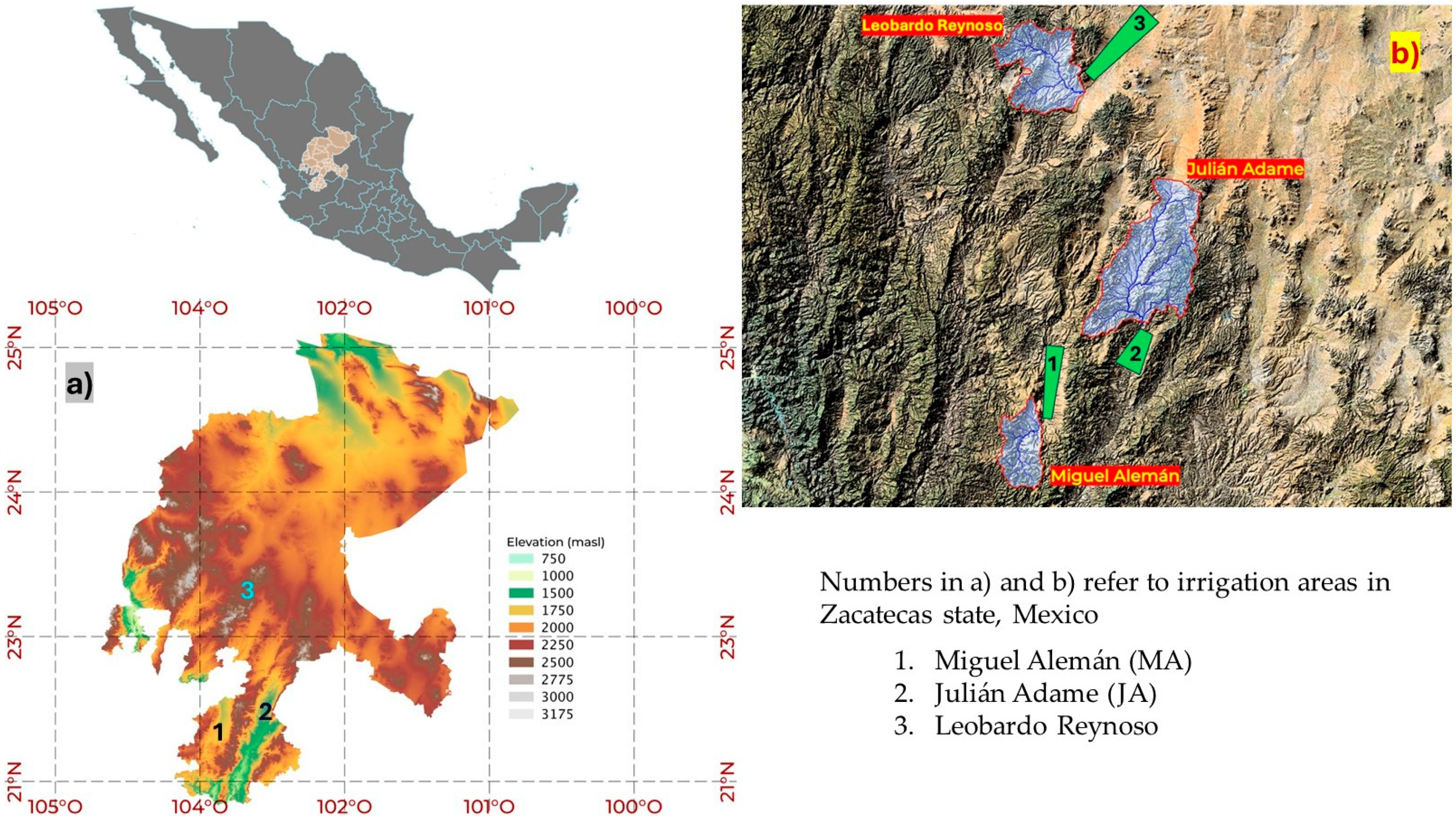
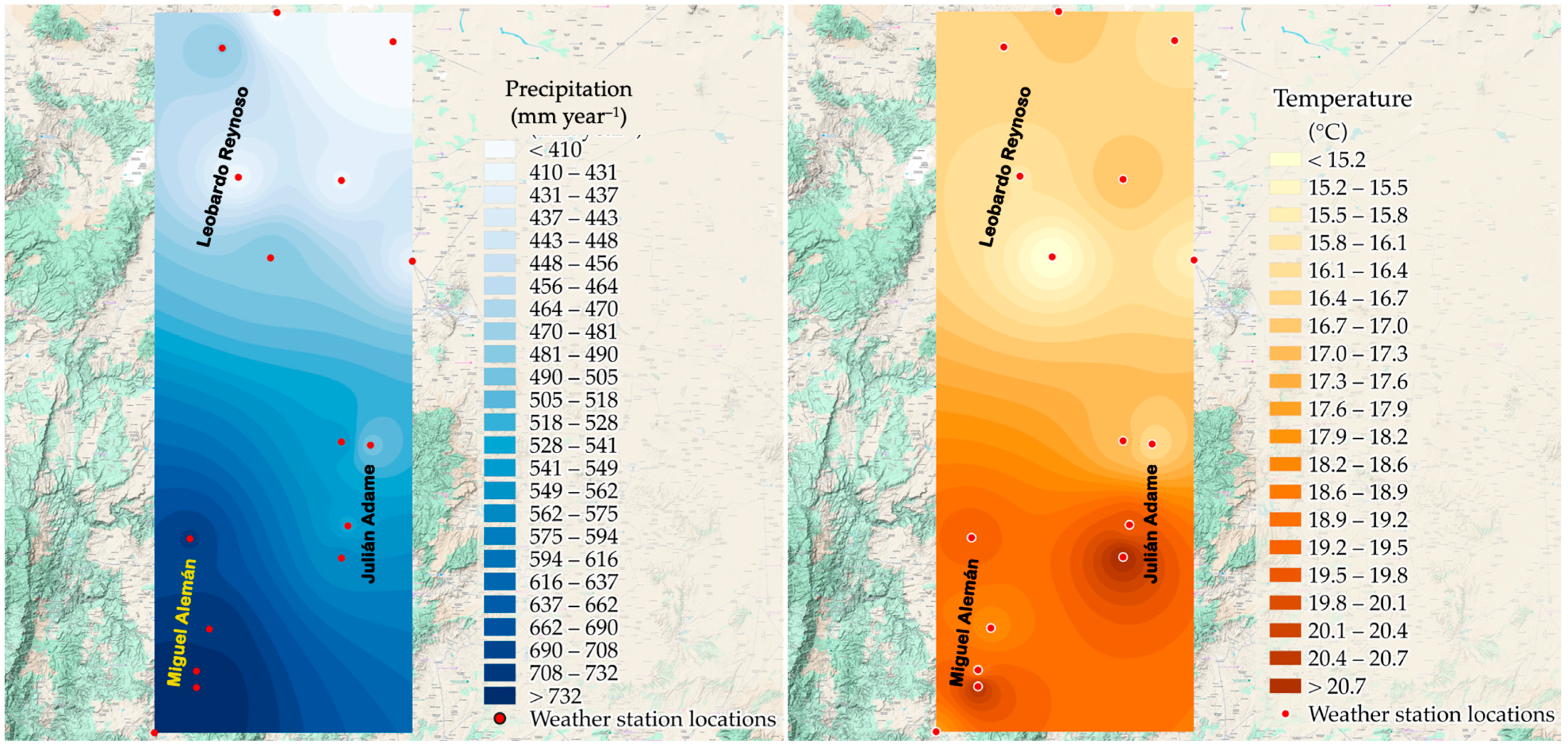



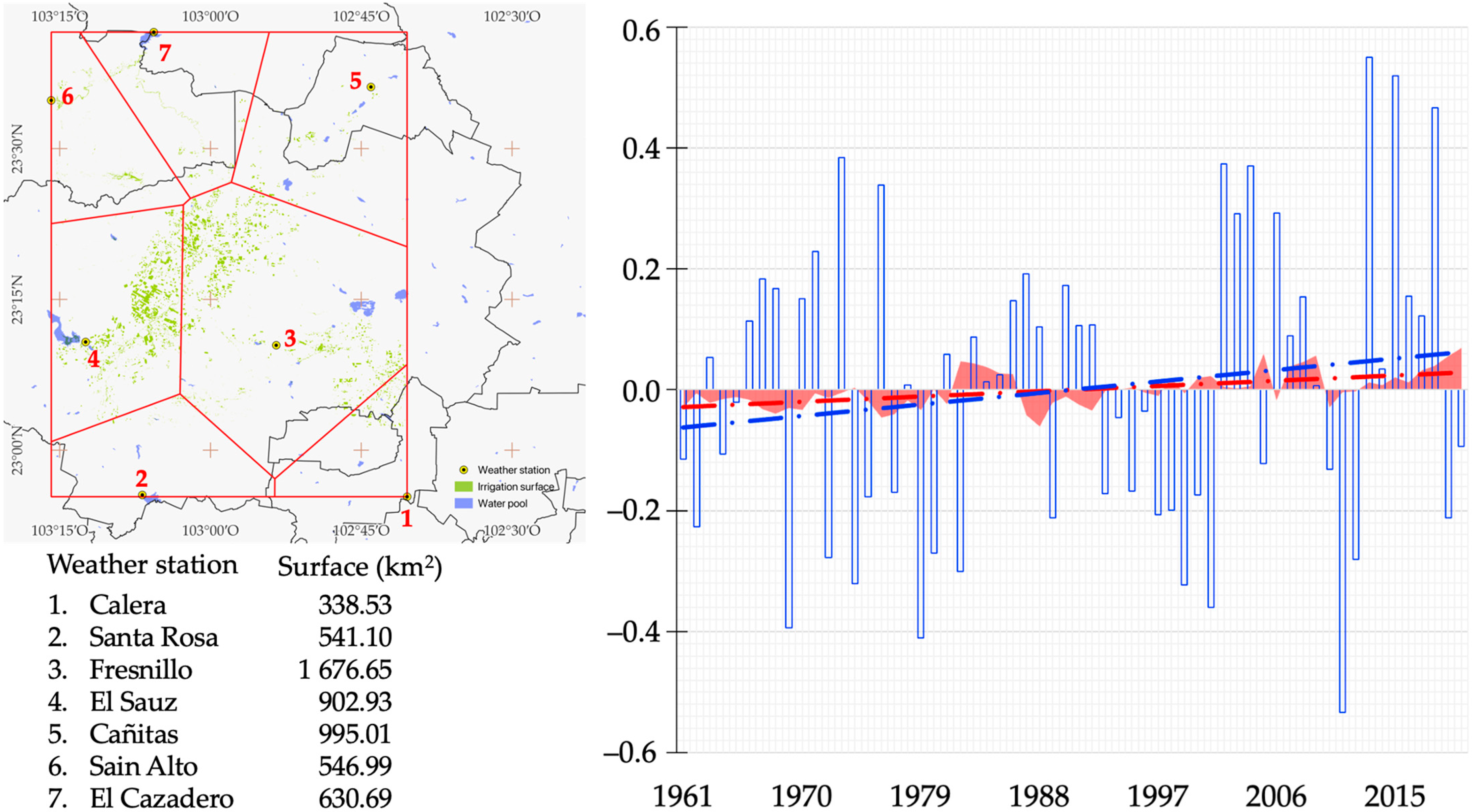
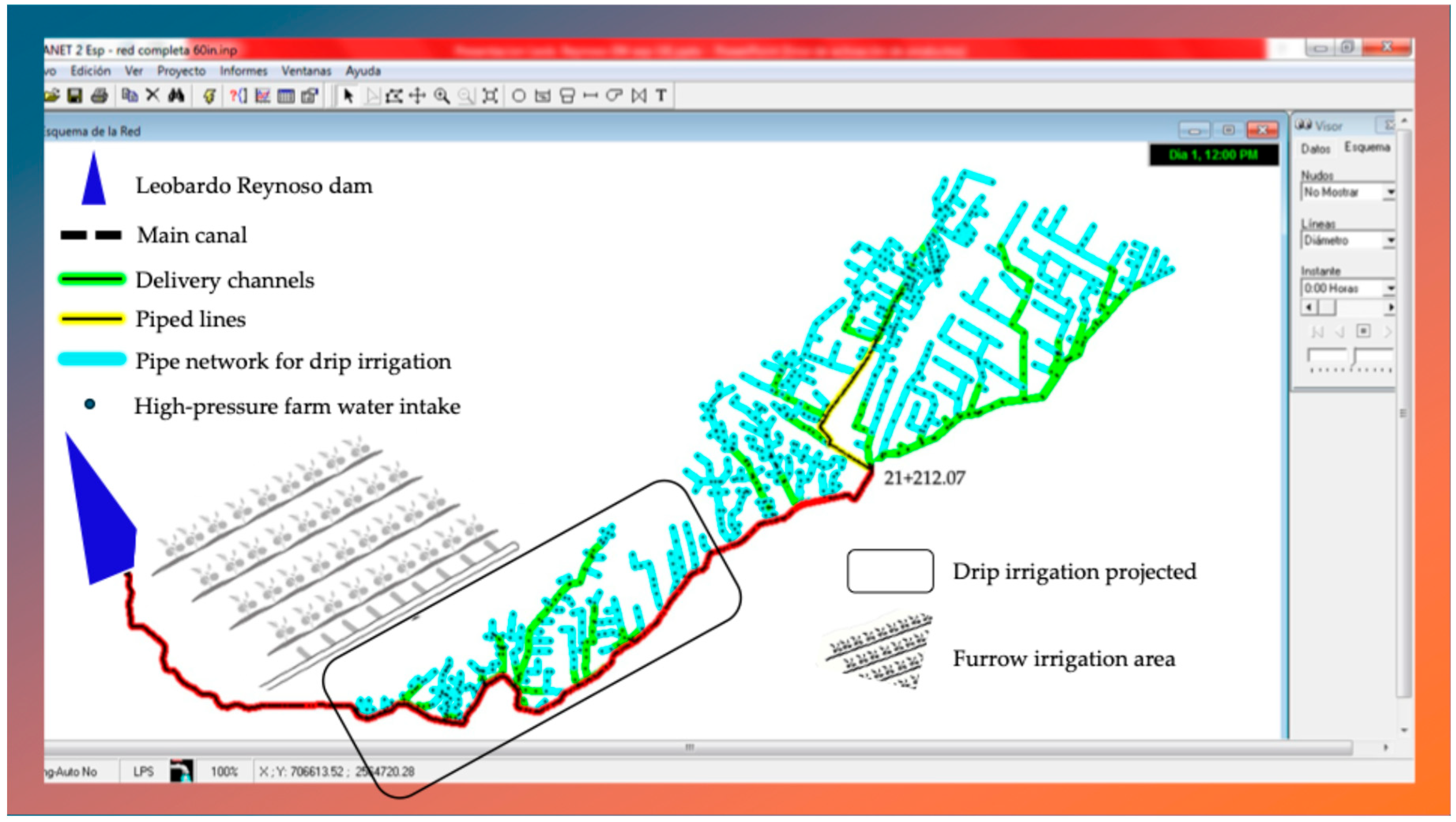
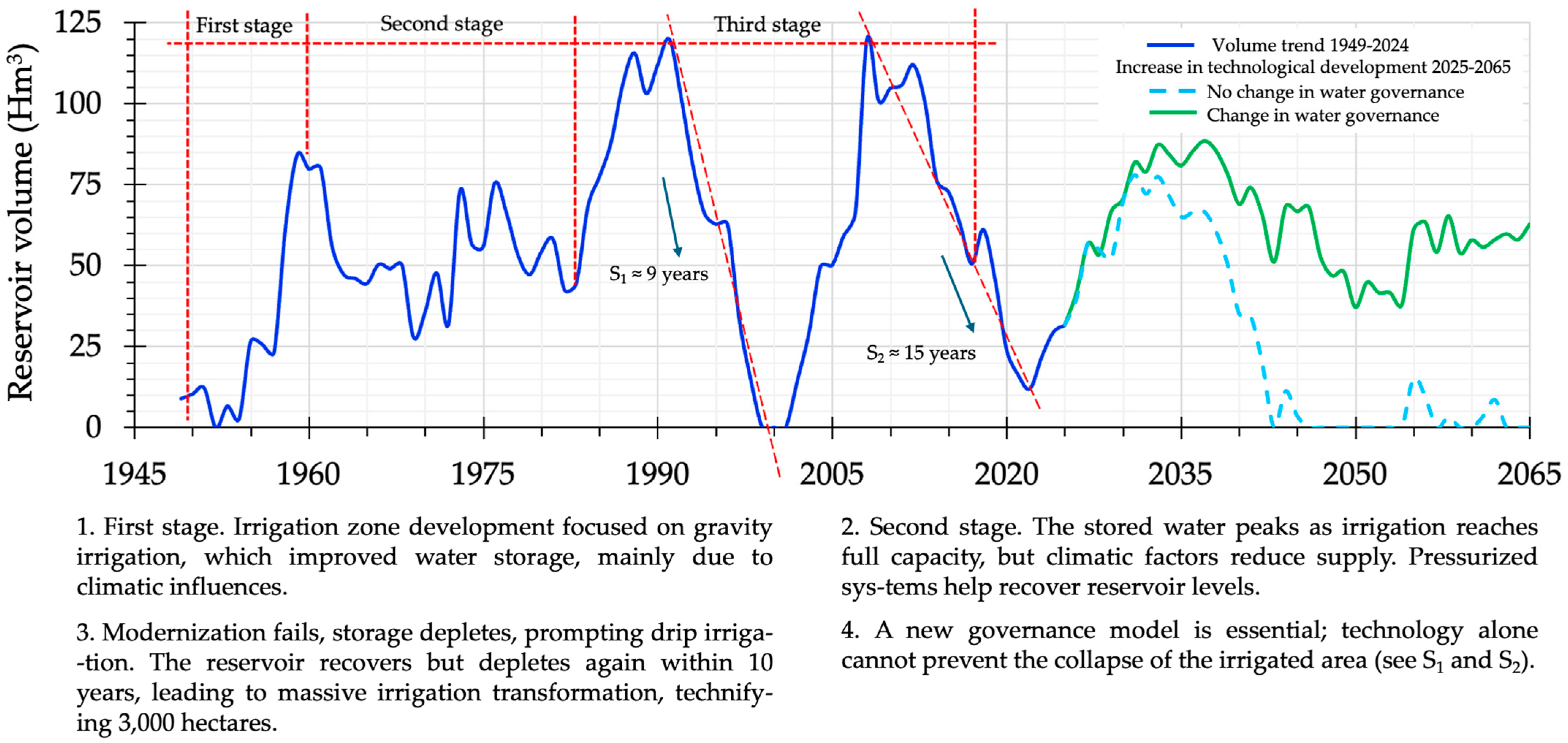
| Irrigation Module | Weather Station | Latitude | Longitude | Elevation | MK Tau | SS | Lreg. | Trend |
|---|---|---|---|---|---|---|---|---|
| (Degrees) | (Degrees) | (Masl) | (mm Year−1) | (mm Year−1) | ||||
| Leobardo Reynoso | Calera | 22.91 | −102.66 | 2097 | 0.050 | 0.341 | 0.343 | Upward |
| Cañitas | 23.60 | −102.73 | 2046 | 0.139 | 0.253 | 0.302 | ||
| Fresnillo * | 23.17 | −102.89 | 2201 | 0.159 | 2.005 | 1.905 | ||
| El Sauz | 23.28 | −103.11 | 2096 | 0.021 | 0.430 | 0.430 | ||
| Sain Alto | 23.58 | −103.26 | 2071 | 0.071 | 0.845 | 0.636 | ||
| Santa Rosa * | 22.93 | −103.11 | 2236 | 0.202 | 1.403 | 1.365 | ||
| El Cazadero | 23.69 | −103.09 | 1862 | 0.068 | 0.739 | 0.739 | ||
| Julián Adame | El Chique | 22.00 | −102.89 | 1648 | 0.084 | 0.697 | 1.002 | |
| Tayahua | 22.10 | −102.87 | 1729 | 0.028 | 0.460 | 0.761 | ||
| Villanueva | 22.36 | −102.89 | 1935 | 0.060 | 0.584 | 0.633 | ||
| Palomas | 22.35 | −102.80 | 2025 | 0.033 | 0.328 | 0.719 | ||
| Miguel Alemán | Excamé | 21.65 | −103.34 | 1740 | −0.090 | −1.092 | −1.276 | Downward |
| La Villita | 21.60 | −103.34 | 1786 | −0.168 | −2.220 | −2.188 | ||
| Casa Llanta | 22.06 | −103.36 | 1730 | −0.046 | −0.536 | −0.571 | ||
| Tlaltenango | 21.77 | −103.31 | 1685 | −0.123 | −1.563 | −1.721 | ||
| Teul | 21.47 | −103.46 | 1909 | −0.093 | −1.037 | −0.983 |
| Irrigation Module | Temperature Minimum (°C) | Temperature Maximum (°C) | ||||||
|---|---|---|---|---|---|---|---|---|
| SD | SD | |||||||
| Julián Adame | 8.6 | 5.4 | −16.0 | 22.5 | 26.8 | 4.3 | 2.0 | 41.0 |
| Leobardo Reynoso | 8.3 | 5.2 | −13.0 | 21.5 | 26.4 | 4.5 | −2.0 | 42.0 |
| Miguel Alemán | 10.1 | 5.1 | −10.5 | 23.5 | 27.4 | 4.9 | −1.0 | 45.0 |
Disclaimer/Publisher’s Note: The statements, opinions and data contained in all publications are solely those of the individual author(s) and contributor(s) and not of MDPI and/or the editor(s). MDPI and/or the editor(s) disclaim responsibility for any injury to people or property resulting from any ideas, methods, instructions or products referred to in the content. |
© 2025 by the authors. Licensee MDPI, Basel, Switzerland. This article is an open access article distributed under the terms and conditions of the Creative Commons Attribution (CC BY) license (https://creativecommons.org/licenses/by/4.0/).
Share and Cite
Bautista-Capetillo, C.; Pineda-Martínez, H.; Flores-Chaires, L.A.; Pineda-Martínez, L.F. Agriculture Resilient at Three Irrigation Modules of Zacatecas, Mexico: Water Scarcity and Climate Variability. Agronomy 2025, 15, 800. https://doi.org/10.3390/agronomy15040800
Bautista-Capetillo C, Pineda-Martínez H, Flores-Chaires LA, Pineda-Martínez LF. Agriculture Resilient at Three Irrigation Modules of Zacatecas, Mexico: Water Scarcity and Climate Variability. Agronomy. 2025; 15(4):800. https://doi.org/10.3390/agronomy15040800
Chicago/Turabian StyleBautista-Capetillo, Carlos, Hugo Pineda-Martínez, Luis Alberto Flores-Chaires, and Luis Felipe Pineda-Martínez. 2025. "Agriculture Resilient at Three Irrigation Modules of Zacatecas, Mexico: Water Scarcity and Climate Variability" Agronomy 15, no. 4: 800. https://doi.org/10.3390/agronomy15040800
APA StyleBautista-Capetillo, C., Pineda-Martínez, H., Flores-Chaires, L. A., & Pineda-Martínez, L. F. (2025). Agriculture Resilient at Three Irrigation Modules of Zacatecas, Mexico: Water Scarcity and Climate Variability. Agronomy, 15(4), 800. https://doi.org/10.3390/agronomy15040800










